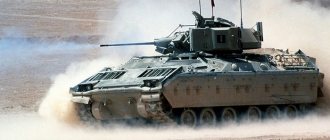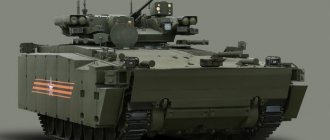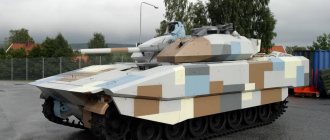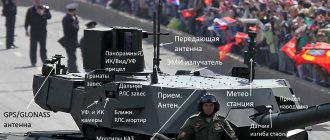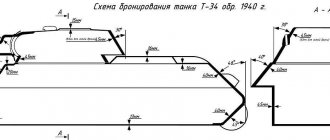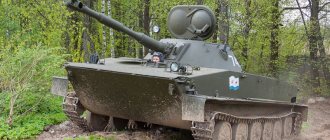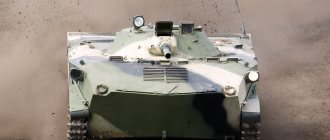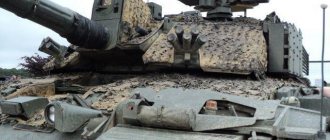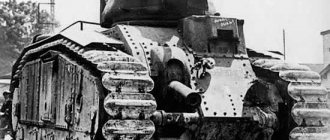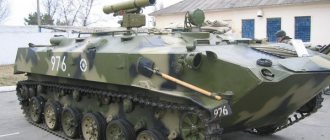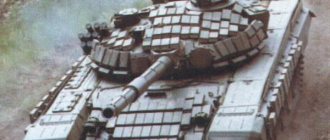Swedish light stealth tank CV90120
It so happens that in real combat events there is no place for light tanks. This is due to the development of auxiliary armor for units, such as armored personnel carriers, infantry fighting vehicles, self-propelled guns, etc. The Swedes look at this problem differently, whose theater of operations in some cases does not allow the use of heavy equipment.
Features of the tactics of using light tanks
Despite the fact that the Swedish Ministry of Defense has chosen the German Leopard 2 tank as its main battle tank, and is replacing the S and Centurion tanks with a new product from German military industrialists, the Hägglunds company continues its cycle of work on a light version of the tank. For this purpose, the CV 90 infantry fighting vehicle is used as a prototype, which has now already been modified and is called CV90120-T. The desire of the specialists of this company to launch the tank into “series” is easily explained.
There are two reasons here that explain the eagerness of Swedish engineers to quickly complete the modernization of the new combat vehicle.
Firstly, the Kingdom's Armed Forces need to equip two Korland brigades, which are stationed in the northern direction, with tanks. The Leopard 2 heavy tank is not suitable for this purpose, since in areas with high levels of snow cover it is necessary to ensure the use of light, walk-through tanks. At the same time, maintaining firepower is very important, i.e. the tank gun must have a caliber of at least 120 mm.
Secondly, a number of Asian, African and South American states may be among the possible clientele, since the purchase of medium and heavy tanks is impractical due to the terrain and the high cost of the project. A light tank is cheaper, especially if its armament corresponds to the category used by medium and heavy tanks. For example, Malaysia was initially interested in the Swedish development of the CV 90-120, but then preference was given to the RT-91 tank (Poland).
Project CV 90-120
In 1997, the Hägglunds company began implementing the CV 90-120 project, during the implementation of which it was revealed that there was a problem with a turret that would correspond to the chassis of a combat vehicle in terms of weight parameters; all proposed options for the turret compartment were bulky and heavy. As a result, a modified turret complex from the IKV 91 product with a 105 mm cannon, which was replaced by a 120 mm gun, was used as the “maison” turret.
Technical equipment
The CV 90-120 tank uses the same chassis as the basic version of the S90 infantry fighting vehicle, with special stiffening ribs added to maintain mass inertia when firing a 120 mm gun. Because of this, the dynamic characteristics of the model have decreased somewhat.
The Scania V-shaped 8-cylinder engine develops a power of 640 hp. s., which creates a good ratio of power and weight of the product for a light tank. The engine is mated to a Perkins X 300 transmission, which is the latest upgrade from the Allison transmission. Weighing 26 tons with ammunition, the product reaches a speed of 70 km/h. The suspension and shock absorbers on the road wheels ensure even distribution of the load on the chassis. The geometric parameters of the tracks and bottom make it easier for the CV 90-120 to move on snow. The driver is equipped with three telescopic devices for viewing the area, the central one of which can be replaced by the AN/WS PN.
The configuration of the product body is smooth, flat, and adapted to the terrain. The engine cooling radiators are located on the right side of the housing, next to the exhaust pipe. This is done to reduce the possibility of the tank being detected by infrared emitters, reducing the tank's coverage area in the infrared zone. The rear compartment has space for ammunition. There is also additional space for a fifth team member, which can also be used for reconnaissance of the area.
Fire capabilities of the tank
The tank's fire capabilities are represented by a 120 mm OTAN standard gun installed in the turret complex. The loader is located on the left side of the tower. It includes an automatic ammunition feeding and loading system. The ammunition cartridge is designed for 12 shots. The rest of the ammunition in the amount of 33 rounds is portable, the storage location is in the rear of the tank. The automatic loading system can withstand a fire rate of 14 rounds per minute.
The tank gun was manufactured by RUAG de Thun (Sweden). This smoothbore gun is equipped with a recoil brake and a soot absorption device. The design of the gun was prepared in the 70s of the 20th century for an early tank project, which for some reason did not go into production.
This gun was taken as a prototype of a new gun, to which a recoil brake was added, which played into the hands of the designers of light turret systems, since the recoil became noticeably less.
Automatic drives for targeting the target make it possible to give the turret a circular rotation with a gun elevation angle from -8° to +22°. The shooter is equipped with a UTAAS target designation device with a laser rangefinder and a thermal imager. The tank commander uses Thales Optronics daytime sighting devices with three times magnification (X1.5; X6; X24)
Adaptiv camouflage system
The CV 90-120 tank uses an infrared camouflage system for the first time. This development has been certified by the Royal Research Institute, and the copyright holder of this “camouflage technology” is the Hägglunds company.
The external components of the Adaptiv system are hexagonal plates, which give it an unusual appearance. With their help, the tank not only turns into “invisibility”, but also shows instead of itself in thermal imagers a false object, a phantom, “drawn” by electronics.
This happens as follows. An image of a truck, for example, in the infrared range with real resolution, is transmitted to the matrix of these components. At a certain distance, this “phantom” is reproduced in the thermal imager. In the event of a threat of a combat strike, the protection sensors activate the camouflage system. The tank is covered in a cloud of spraying aerosol. A capacity of 300 liters of aerosol composition is enough to hold the invisible screen for more than two minutes. The configuration of the tubes is such that the sprayed liquid creates an effect similar to the wavelength in the IR range, between 5 and 25 Mm, resulting in the desired phenomenon of light absorption.
According to the project manager at Hägglunds, infrared camouflage is just the beginning; they are working on creating a similar effect with radar systems
Electronic protection CV90120
Electronic protection CV90120 is the merit of Celsius Tech et Grintek Avitronics. Laser detectors from Thales Optronics keep the crew aware of the course towards the target conducting the reconnaissance search. Here there is the option of setting up special interference or physically destroying the target. The radar provides information about the possible detection of a target by enemy technical means or the start of enemy fire using aviation or artillery.
The instrument complex “launches” aerosol camouflage or shoots grenades to set up special screens.
5:02 / 07.28.15 Weapons of the world: light tank CV90120-T (Sweden)
In 1998, the Swedish company BAE Systems Hagglunds showed its latest development at the Eurosatory exhibition in Paris - a light tank (tank destroyer) CV90120-T
, created as a private initiative based on a modified CV90 infantry fighting vehicle chassis. The chassis is equipped with a modified three-man turret from the Ikv-91 tank destroyer, armed with a Swedish-made 120 mm smoothbore gun. The first prototype, CV90120, was completed in mid-1998, and firing was conducted in late 1998.
Project CV 90-120 / Photo: www.dogswar.ru
The first demonstrator model, CV90120, had a three-man TML105 turret manufactured by Nexter Systems, armed with a 105 mm rifled gun. Standard NATO ammunition was used for firing. Then the CV90120-T
on a CV90 chassis, equipped with a new three-seat turret manufactured by BAE Systems Hagglunds. The tank's armament consists of a 120 mm L50 smoothbore gun manufactured by RUAG Land Systems and a coaxial 7.62 mm machine gun. The 120-mm smoothbore gun is equipped with a muzzle brake, a thermal casing, a powder gas extractor and a bore zeroing system.
The CTG gun was developed by the Swiss company RUAG specifically for installation on light and small armored vehicles. To reduce recoil, the gun is equipped with a muzzle brake. There is an ejector to purify the barrel after a shot. The gun barrel is enclosed in a thermally insulating casing to improve shooting accuracy. The gun is stabilized in two planes.
A semi-automatic loader for 12 rounds is mounted in the rear part of the turret. When using it, the rate of fire can reach 12-14 rounds/min. The rest of the ammunition (33 rounds) is located in the rear of the hull and can be quickly loaded through the aft door.
Equipped with such weapons, the CV90120-T light tank has the same firepower as the Leopard 2 main battle tank, however, with a combat weight of 35 tons, it has better strategic and tactical mobility. The full ammunition load is designed for 45 rounds, of which 12 are ready for firing, and 33 are stored in racks. For comparison, the Leopard 2 tank has 42 rounds of ammunition. It is claimed that thanks to the use of a digital fire control system (FCS), a high probability of hitting moving and stationary targets from the first shot is achieved.
Project CV 90-120 / Photo: www.dogswar.ru
Tank CV90120-T
has a layout with a front engine compartment and drive wheel. This is due to the fact that its chassis is a further development of the CV9040 infantry fighting vehicle chassis. The BMP chassis was modified to accommodate a three-man turret in the rear, and the front armor was strengthened.
CV90120-T armor along the front arc of the hull and turret provides protection against 30 mm armor-piercing projectiles, and bulletproof protection from all sides of 12.7 mm caliber. In addition to the main armor and aerosol system for countering guided weapons, the CV90120-T was equipped with an active armor concept (AAC), which was developed for the Swedish army by the German company IBD Diesenroth Engineering together with the Swedish company Akers Krutbruk. Outside Sweden, Diesenroth offers this system as part of its Advanced Modular Defense System (AMAP-ADS or simply ADS). In the UK, the system was labeled “Hard-Kill DAS” (Defense Assisted System).
The exact details of the system modules have not yet been disclosed, but it is known that the module consists of sensors and an interception system and can be installed to protect both the top and side projections from cumulative missiles, armor-piercing anti-tank projectiles and projectiles with an emerging explosion core.
Photo: www.dogswar.ru
New active armor provides better protection against anti-tank guided missiles; an improved on-board screen was installed to reduce the vehicle’s signature in the infrared field; The vehicle also has a camouflage paint job for operations in urban environments. Active armor, according to the developers, is an “advanced active protection system” that “detects, identifies and eliminates short-range attack.” The system has been successfully tested on the CV90 chassis. Then it became known that this protection covers 360 degrees. around and increases the weight of the car by 400 kg. The use of the AMAP-ADS active protection system and the replacement of more than 2 tons of passive armor, while maintaining the internal volume, makes it possible to reduce the weight of the vehicle by 1.6 tons.
The main reason for installing a 120 mm gun was the desire to combine the firepower of a tank with the mobility characteristics of a lighter vehicle. Combat weight CV90120-T
is about 35 tons, while the tank weighs almost twice as much. The CV90120-T turret is equipped with a 120 mm Compact Tank Gun CTG120/L50 cannon, manufactured by Swiss Ruag. In the mid-1990s, a Giat TML turret with a 105 mm gun was installed on the CV90 chassis, but unlike the new gun, it was not fully stabilized.
Fire control system CV90120-T - Universal tank fire control system, providing the ability to shoot at air targets (UTAAS), manufactured by SAAB. The same system was used in the CV90. A Hagglunds spokesman said that with UTAAS, the CV90 series vehicles "have higher shooting accuracy than Leopard 2 tanks."
The gun's ammunition includes feathered armor-piercing discarding sabot (APFSDS) projectiles, in addition, it is planned to introduce high-explosive rounds, also being developed by Israel Military Industries for the Leopard-2 main battle tank, as an alternative to standard cumulative ammunition.
The gunner has at his disposal a universal tank/anti-aircraft sight "Celsiustek" with day and night channels and a laser rangefinder, which is available for equipping other combat vehicles.
Crew CV90120-T
consists of 4 people - commander, gunner, infector (second commander) and driver. The driver's workplace is located in the front part of the hull on the left side. The workplaces of the remaining crew members will be located in the fighting compartment. The gunner and commander will be positioned to the right of the gun (the gunner is in front, and the commander is behind him and higher). The loader is located to the left of the gun.
The CV90120-T fire control system consists of three independent elements. The gunner has UTAAS, a system that includes a stabilized day/night sight and a laser rangefinder. The commander's fire control system, DNGS, has approximately the same capabilities as the gunner's, but his sight has the ability to change the magnification within the range of 1.5, 6 and 24 times. In addition, there is another PLSS aiming system - it can be used by both the gunner and the commander. Moreover, the commander can search for targets and transfer them to the gunner for destruction. All crew members have monitors connected by a common data bus, which increases the efficiency of controlling the CV90120-T in combat.
Camouflage system / Photo: topwar.ru
The CV 90-120 tank uses an infrared camouflage system for the first time. This development has been certified by the Royal Research Institute, and the copyright holder of this “camouflage technology” is the Hägglunds company.
The external components of the Adaptiv system are hexagonal plates, which give it an unusual appearance. With their help, the tank not only turns into “invisibility”, but also shows instead of itself in thermal imagers a false object, a phantom, “drawn” by electronics.
This happens as follows. An image of a truck, for example, in the infrared range with real resolution, is transmitted to the matrix of these components. At a certain distance, this “phantom” is reproduced in the thermal imager. In the event of a threat of a combat strike, the protection sensors activate the camouflage system. The tank is covered in a cloud of spraying aerosol. A capacity of 300 liters of aerosol composition is enough to hold the invisible screen for more than two minutes. The configuration of the tubes is such that the sprayed liquid creates an effect similar to the wavelength in the IR range, between 5 and 25 Mm, resulting in the desired phenomenon of light absorption.
According to the project manager at Hägglunds, infrared camouflage is just the beginning; they are working on creating a similar effect with radar systems. Chassis CV90120-T
(one side) consists of seven double road wheels, a front drive wheel and a idler wheel installed in the rear of the hull. The guide wheel has a hydraulic tension mechanism controlled from the driver's seat. The caterpillar is made up of single-ridge steel tracks with rubber running tracks. The tracks are connected using a rubber-metal hinge. The suspension of the rollers is individual torsion bar. Double-acting hydraulic shock absorbers are installed on the suspension units of the first, second and seventh rollers.
The engine and transmission compartment of the tank is located in the front part of the hull on the starboard side. It is equipped with a four-stroke liquid-cooled diesel engine V-8 Scania DI16 with a power of 670 hp. It drives the tank through a Perkins Engines Company / Allison X-300 automatic transmission with four forward gears and two reverse gears. Although the CV90120-T tank destroyer is being developed by BAE Systems Hagglunds on its own initiative, the company's management brought to the attention of the Swedish army command that the CV90120-T is a potential replacement for the outdated Ikv-91, the cumulative projectile of which is no longer effective against the armor of the latest generation tanks.
Main buyers of CV90120-T
, obviously, will be the countries in which the CV90 series machines are currently used: Finland, Norway, Sweden and Switzerland. This modernization also interested Denmark and Holland. The development of the CV90120-T has been fully completed and the vehicle is ready for mass production. To date, there are no orders for its production.
Photo: topwar.ru
Characteristics of CV90120-T
| Weight, kg | 28000 |
| Crew, man | 4 |
| Length, mm | 8900 |
| Width, mm | 3200 |
| Height, mm | 2800 |
| Maximum speed on the highway, km/h | 70 |
| Gradient, % | 60 |
| Slope, % | 40 |
| Trench, mm | 2400 |
| Vertical wall, mm | 1000 |
| Water hazard depth, mm | 1500 |
| Cruising range on the highway, km | 600 |
| Main gun caliber, mm | 120 |
| Main gun ammunition, pcs. | 45 |
| Elevation angle, maximum, degrees | 22 |
| Declination angle, minimum, degrees | -8 |
| Auxiliary gun caliber, mm | 7.62 |
| Gun stabilization planes | 2 |
| Stabilization planes for the gunner's field of view | 2 |
| Panorama, pcs. | 1 |
| Thermal imager, pcs. | 2 |
| Engine power, hp | 615 |
| Number of forward gears | 4 |
| Number of reverse gears | 2 |
When writing the material, data from open Internet sources was used:
1.
Dogs War
website . Military Review website, article
Lebedev Sergei
Tags: Weapons of the world, light tank, CV90120-T, Sweden
Swedish armor: CV-90 family of combat vehicles
Work on developing an armored weapon system for the 1990s in Sweden began in 1982. The leadership of the Swedish armed forces wanted to get a new main tank and a family of armored vehicles on a single unified tracked chassis. Initially, their plans included the creation of an infantry fighting vehicle armed with a 40- or 57-mm cannon, a Pbv L armored personnel carrier with a 25-mm cannon, a fire support vehicle (symbol of the Pbv G vehicle), a Pvkv A2 self-propelled gun, a KShM (command staff vehicle), advanced vehicles artillery observers, a self-propelled mortar, an armored medical vehicle and a self-propelled ATGM. The lead and primary vehicle in this family was to be a 20-ton infantry fighting vehicle, characterized by good armor protection, high maneuverability and fairly powerful weapons. The fire support vehicle differed from the BMP by the presence of the Bill ATGM ( see details >>> ), the development of which at that time had entered its final stage. The first CV90 infantry fighting vehicles were planned to be sent to the Nordland infantry brigades.
According to Swedish documents, the family of combat vehicles being developed received the traditional Swedish designation “Stridsfordon 90” (or “combat vehicle of the 90s” - Strf 90), but later the more commonly used English designation “Combat Vehicle 90” or abbreviated CV90 became most widespread.
In 1985, a small company organized jointly with Hagglunds und Sonar (later Hagglunds Vehicles) received a contract from the Main Logistics Directorate of the Swedish Ministry of Defense to develop five prototypes of the CV90 basic combat vehicle. In the same year, Hagglunds presented a full-scale wooden model of an infantry fighting vehicle, which already showed the future design of the vehicle. Somewhat earlier, separate tasks were issued for the development of a two-seat turret and an automatic diagnostic system for the vehicle’s condition. In 1986, contracts were signed for three versions of the turret with a 40 mm gun and one with a 25 mm gun. Since 1985, the 40-mm Bofors cannon has been tested on the chassis of the Swedish 15.5-ton amphibious tank Ikv 91. Options for installing the automatic 57-mm Trinity Bofors cannon based on the universal shipborne SAK57 Mk2 or 60-mm Israeli HVMS- 60 IMI.
To speed up the work and reduce its cost, components and assemblies from various companies, including foreign ones, were used. The Norwegian Cverner, the Swiss Oerlicon, the German Mauser, the American McDonnell Douglas Helicopter and FMC together with Emerson Electric took part in the development of the tower. The French SAMM (with a 40-mm Bofors cannon) and Kreso-Luar (with a 25-mm Bushmaster cannon) also presented their turret versions.
Infantry fighting vehicle Strf 9040 ( CV 9040)
The CV90 infantry fighting vehicle was developed specifically taking into account the rather specific climatic and territorial conditions of Sweden. This is a fairly compact and maneuverable vehicle, with a fairly low silhouette, low radar pulse reflection coefficient and weak thermal radiation in the frontal projection, reduced noise level and vulnerability to the effects of electromagnetic pulses. Through many years of research and technical development, Hagglunds ensured that the new combat vehicle fully complied with all the requirements of the Swedish army for tactical and operational mobility, security and firepower.
Increased tactical mobility was to be achieved by reducing the specific ground pressure, high ground clearance, high specific engine power, increasing the maximum speed and increasing the maneuverability of the vehicle. The requirements for ensuring high strategic mobility provided for the possibility of transporting vehicles by rail and ensuring a large fuel range.
The vehicle and its crew had to be provided with the necessary protection by large angles of inclination of the hull armor plates, a low silhouette, reliable protection against weapons of mass destruction, and a fast-acting and reliable fire safety system. In addition, one of the requirements was the possibility of providing independent protection from air attacks, which provided for the installation of a weapon system with large vertical guidance angles of the main weapon, with a high rate of fire and high guidance speeds in both planes.
The requirements for the firepower of a combat vehicle provided for the ability to fight armored targets. For this, it was planned to install a 40-mm automatic cannon, the sub-caliber projectiles with a tungsten core capable of hitting almost all armored targets, with the exception of main tanks, in the frontal projections.
In addition, the Swedish military put forward additional requirements for the vehicle, such as ease of operation and the possibility of further development and improvement of the vehicle. For this purpose, conditions were put forward such as the use of cheap spare parts and mechanisms in the design of the machine, limited use of electronics, and ease of maintenance. To create the potential for further improvement of the infantry fighting vehicle, it should have been possible to mount new weapon stabilization systems, new types of armor and other protection, as well as increase the firepower of the weapon system without significant changes to the design of the infantry fighting vehicle.
The first prototype of an infantry fighting vehicle with a 40-mm cannon was handed over for testing in October 1988. In May of the following year, a pre-production sample was presented. The Swedish Ministry of Defense issued the first order for 200 production vehicles in 1991 with the condition that deliveries begin in October 1993 and end in 1997. The total contract value was SEK 2.9 billion.
In 1993, the CV90 infantry fighting vehicle with a 40-mm automatic cannon, designated CV9040, was put into service, and the first 30 vehicles entered service. This event coincided with the selection of a new main tank for the Swedish army. True, it was not a Swedish-designed tank (the Ministry of Defense stopped designing the Stridsvagen 2000 tank back in 1991), but the German Leopard 2A5 tank (Swedish designation Strv 122), which won the tender against the Russian T-80U despite the fact that that the Swedish military for the most part were in favor of the Russian car. As it turned out later, the decision in favor of a German tank was made by the Swedish government due to fears of a change of power in Moscow after the well-known events in October 1993. In 1995, the Swedish Ministry of Defense decided to order another 150 infantry fighting vehicles, bringing the total cost of the order to 3, SEK 7 billion.
The entire chassis of the vehicle is built at the enterprises, after which they are transferred to the enterprises where the turret with the weapons complex is installed and the installation of the equipment is completed. The army already delivers finished vehicles directly. The CV90, one of the second generation infantry fighting vehicles, belongs to the class of “heavy” vehicles, capable of more successfully and closely interacting with tanks in battle conditions saturated with a variety of weapons, including anti-tank ones.
The layout of the CV9040 vehicle is classic for an infantry fighting vehicle: the MTO is located in the bow of the hull on the right, the driver’s seat is located to the left of it, the weapons are installed in a rotating turret in the middle part of the vehicle’s hull, and the troop compartment is located in the rear of the hull. The turret is shifted 200 mm to the left of the longitudinal axis of the hull, thereby balancing the right-hand position of the engine. The gunner's workplace is located in the turret on the right, the commander's - on the left. Each turret roof has hatches, the armored covers of which fold back.
Eight paratroopers sit along the sides, which provides more free space inside the troop compartment and convenient embarkation and disembarkation of paratroopers through a wide ramp that folds down in the stern. In addition, in the roof of the troop compartment there are two rectangular hatches with lids that fold up.
The all-welded armor steel hull and turret have large angles of inclination of the frontal plates. The armor can be enhanced by additional removable elements that provide protection against armor-piercing shells from 20-30 mm automatic guns.
The chassis is covered with removable screens. Additional protection for the frontal projection of the turret is provided by spare tracks attached to it. The maximum width of the tower is 2180 mm, the total height with suspended floor is 1520 mm. The turret's armored mask is equipped with a 40-mm L70B (40/70B) automatic cannon based on its well-known L70 anti-aircraft gun of the 1951 model. To place the cannon in the turret, it had to be turned 180° with the magazine facing downwards, causing spent cartridges to be thrown up forward through the roof of the turret. A conical flame arrester is attached to the muzzle of the gun, and the recoil devices are covered with a box-shaped armored casing. The maximum gun elevation angle is +50°, declination -8°. Vertical guidance of the gun and rotation of the turret are carried out by electric drives, but if necessary, backup mechanical manual drives can be used.
The L70 has developed several types of ammunition for firing the cannon:
• APFSDST – tracer finned armor-piercing discarding sabot projectile with a detachable tray,
• PFPP – programmable fragmentation projectile with a remote fuse,
• PFHE Mk2 – high-explosive fragmentation projectile with a remote-impact fuse (this and the previous types of ammunition are used to combat aircraft and helicopters),
• HET – high-explosive fragmentation tracer projectile,
• MRT – multi-purpose tracer projectile (used to destroy ground targets and enemy personnel),
• TRT – training tracer projectile.
The body of the finned sabot projectile, which is also an armor-piercing core, weighing about 0.5 kg, is made of tungsten alloy. It has a high aspect ratio and an initial speed of 1600 m/s. The armor penetration of this projectile is up to 140 mm normal at a range of up to 1.5 km.
The gun's ammunition consists of 240 rounds of high-explosive fragmentation and armor-piercing sub-caliber tracer shells with a detachable tray. The gun is fed from a three-section box magazine in which 24 shots are loaded - eight shots in each section. Sections can be reloaded manually from ammunition racks within 20 seconds. 48 rounds are located in a rotating drum on the turret floor, another 168 rounds are placed in ammunition racks in the vehicle body in the fighting compartment.
The power system allows you to quickly switch from one type of shot to another. Fire is carried out in single shots or bursts at a rate of fire of 60 and 300 rounds/min. The effective firing range against tanks in the side or rear projection and armored vehicles reaches 1.5–2 km, against helicopters 3.5–4 km.
A 7.62 mm Ksp m/39 machine gun is paired with the cannon. To install it, a special tide was made on the side of the tower. Its ammunition capacity is 2000 rounds. On one of the first experimental versions of the turret, the coaxial machine gun was located in a special influx on the right side of the turret and was rigidly connected to the vertical guidance mechanism of the gun.
Smoke grenade launchers are located in two blocks on the sides of the tower. Initially, the units included 6 barrels, but production vehicles are equipped with three-barrel grenade launchers.
The automated fire control system (AFS) of the development includes a MYBOF ballistic computer, a Simrad Nd-YAG LV-401 laser rangefinder with a range from 200 m to 9990 m and a measurement accuracy of ±10 m, a set of sensors, a combined NTAA gunner sight with a stabilized two planes with an independent line of sight, a laser rangefinder and a thermal imaging channel. The optical channel has variable seven- and two-fold magnification, the night channel has only 4.7-fold magnification. The head part of the sight is covered with an armored cap with a hinged lid. Most of the gunner's functions are performed using a remote control with two handles on which the gunner's palms rest. With the thumb of his right hand he activates the laser rangefinder, with the index finger of the same hand he presses the electric trigger of the machine gun, and with the index finger of his left hand he presses the electric trigger of the gun. Some of the other buttons are also located near the palm, which allows a well-trained gunner to work without looking up from the observation and aiming device. The control panels of the fire control system are grouped on the right wall of the housing. With their help, you can manually enter the data necessary for firing, while simultaneously monitoring the specified parameters, which are displayed on a small screen.
The vehicle commander's workplace is equipped with a circular rotation commander's turret with periscopes and a "Sopelem" M371 observation and aiming device. In the horizontal plane and at 1x magnification, the viewing sector of one eyepiece is 38°, in the vertical plane – 12°. When using two eyepieces these values change to 77° and 32° respectively. The commander can switch the magnification to 6x, but the field of view narrows to 10°. The manufacturer guarantees reliable operation of the device in the temperature range from -40°C to +70°C. To protect the commander's eyes from being blinded by laser radiation, there is a special filter. The commander controls the main weapon using a joystick, which has a button for selecting the type of weapon (cannon or machine gun) under the thumb. The electric shutter button is located under the index finger. Thanks to this solution, basic functions are performed quickly and accurately.
There are no installations for landing weapons. Fire by paratroopers from personal weapons can be carried out with the upper hatch covers partially open. This approach is perceived ambiguously: on the one hand, the absence of rifle installations reduces the density of fire and turns paratroopers into ordinary passengers, on the other hand, the security of the sides of the vehicle increases.
The power plant for the CV-9040 (as well as for other vehicles in this family) is a turbocharged and intercooled SAAB Scania DS14 diesel engine, which develops a maximum power of 555 hp. at 2200 rpm. Together with the transmission, it forms a single monoblock. In 1988, a modified transmission of the “Cross Drive” X400-4B type, produced under English license (the British used it for their Warrior infantry fighting vehicle), was tested for the first time on the CV90. However, similar automatic units X300-5 were usually installed, providing forward movement at four speeds and reverse at two speeds. The X300-5 transmission consists of a hydromechanical transmission with a lock-up clutch, a planetary gearbox, a differential mechanism with a hydrostatic transmission, a multi-plate clutch and two final drives.
The power plant and transmission provide the CV9040 IFV with a maximum speed of up to 70 km/h when moving forward and 43 km/h when moving, and accelerates from a standstill to 30 km/h in just 7 seconds. Access to the engine and transmission is provided by a removable inclined plate, which also serves as the MTO roof. To ensure the lowest possible profile of the vehicle, the radiator of the engine cooling system is located on the right in the rear of the hull, as in the German Marder infantry fighting vehicle. Placing the control compartment next to the engine-transmission compartment significantly simplified the control system for the engine, gearbox and turning mechanisms. The driver changes the direction of movement using the steering wheel, and the use of hydrostatic transmission in the control system allows the vehicle to be turned with arbitrary radii. The CV9040 can also rotate around its own axis, which is especially important when maneuvering in populated areas, in the mountains and in the forest.
The main fuel tank with a capacity of 525 liters is installed along the left side of the hull on the fender. The tank walls and fuel act as additional protection against cumulative ammunition. Batteries are located in the aft part of the left side, and on the starboard side additional protection is provided by boxes for spare parts and tools, a radiator and exhaust system elements.
The driver's hatch, which folds back, is equipped with three periscopes to monitor the terrain ahead of the vehicle. The viewing sector covers 158°. If necessary, the central periscope can be replaced with a passive night vision device. At the bottom of the control compartment behind the driver's seat there is a hatch for emergency exit from the car.
Two 71-mm launch tubes of the “Liran” system are installed on the roof on a hinge for launching lighting and smoke rockets at a distance of up to 1300 m. Such an area illumination system is not at all out of place in the conditions of the Scandinavian north with long nights.
The CV9040 chassis consists of fourteen (seven on each side) steel double road wheels with rubber tires, two front drive gears, two rear idler wheels and two tracks. There are no support rollers, although the possibility of their use was considered during sea trials. In the stern of the BMP there are hydraulic mechanisms for tensioning the tracks.
By pressing the appropriate pedal, the driver can change the track tension without leaving his workplace, which has greatly simplified this labor-intensive and time-consuming procedure. The hydraulic system tanks are located in the rear part on the fenders. The single-ridge caterpillar consists of 84 tracks with a width of 535 mm with a pitch of 152 mm, connected by locks with special lugs, making it easier to move through swampy terrain and deep snow. Due to the large length of the supporting surface (about 4 m), the value of the specific pressure on the ground is 0.48-0.53 kg/cm2. Removable rubber asphalt pads can be installed on the outer surface of the tracks.
The suspension on the CV9040 BMP is individual torsion bar. In this case, the first, second and seventh suspension units are equipped with rotary hydraulic shock absorbers. The upper tracks of the tracks are covered with armored screens, which provide additional protection for the sides of the hull from cumulative ammunition. Low specific ground pressure combined with high specific power (24.1 hp/t) provide the vehicle with high maneuverability and mobility even on soft soils and snowy terrain.
The standard equipment of the CV90 family vehicles includes a protection system against weapons of mass destruction, developed by the English company MDH, and a fire extinguishing system located in the engine compartment.
In addition to the CV9040 infantry fighting vehicle, armed with a 40-mm cannon, other variants of the combat vehicle have been created, which differ in turret equipment and cost. This made it possible to adapt to the specific requirements and capabilities of potential foreign customers.
The fire support vehicle version inside the CV9040 provides for the placement of a crew, a launcher and an ATGM for the RBS-56 “Bill” ATGM. The crew fires from the ATGM from the vehicle through the hatch of the troop compartment or from the ground. The BMP crew is not distracted by working with anti-tank systems.
Light tank (tank destroyer) CV 90120- T
In 1998, the Swedish presented in Paris its new development - a light tank (tank destroyer) Grkpbv 90120 (GranatKastarPansarBandVagn), better known under the export designation CV90120-T, created on the basis of a modified CV90 infantry fighting vehicle chassis. A modified three-man turret from the Swedish lkv-91 tank destroyer, equipped with a 120-mm smoothbore gun, also made in Sweden, was mounted on this chassis. The first prototype was built in mid-1998, and the first firing was carried out at the end of the year.
The first demonstration model of the tank was equipped with a 105 mm TML105 rifled gun, but in the end the developers opted for a Swiss-made 120 mm L50 smoothbore gun and a coaxial 7.62 mm machine gun. This weapon was developed by a Swiss company specifically for installation on small and light armored vehicles. In order to reduce recoil, it is equipped with a muzzle brake. To improve shooting accuracy, the gun barrel is placed in a special thermal insulation casing. An ejector is used to purge the barrel of powder gases after a shot.
The gun is stabilized in two planes. The main reason for installing the 120 mm gun was the desire of Swedish engineers to combine the mobility of a lighter combat vehicle with the firepower of a main tank.
At the rear of the three-man turret of the CV90120-T tank destroyer there is a semi-automatic loader with 12 rounds. When used, the gun's rate of fire can reach 12–14 rounds per minute. The gun's full ammunition load consists of 45 rounds, of which 12 are initially ready for firing, and another 33 are located on special racks in the rear of the hull. From there they can be quickly loaded into the tower through a special aft door.
With such impressive armament, the CV90120-T light tank is comparable in firepower to the German Leopard 2 main battle tank, while weighing 35 tons and having much better tactical and strategic mobility.
This light tank has a front-mounted MTO and drive wheels, which is due to the fact that its chassis is a further development of the CV9040 infantry fighting vehicle chassis. To accommodate a heavier three-seat turret at the rear of the vehicle, the chassis was slightly modified, while the armor of the front projection was strengthened.
The armor of the light tank in the frontal projection of the turret and hull provides protection for the crew from being hit by armor-piercing 30 mm shells, and also provides bulletproof protection against bullets of caliber up to 12.7 mm in all projections. In addition to the main armor and a special aerosol system to counteract guided weapons guided by a laser beam, the tank is equipped with an active protection system, which was developed for the Swedish army by German designers together with the Swedish one. The exact details of the modules of this active protection system have not yet been disclosed. It is only known that the system consists of a number of sensors and an interception system and can be used to protect both the top and side surfaces from the effects of armor-piercing shells and cumulative missiles.
The new active armor, according to the developers, provides the vehicle with better protection against guided projectiles. Additional on-board screens reduce the vehicle's signature in the infrared field. In addition, the tank received a traditional camouflage paint job for combat operations in urban environments. Active armor, according to the developers, is an “advanced active protection system” that is able to detect, identify and eliminate a threat at short range.
The fire control system of the CV90120-T tank is a universal tank fire control system manufactured by SAAB, which also provides the ability to fire at air targets. The OMS consists of three independent elements. The gunner has a UTAAS system, which consists of a combined (day/night) sight with a line of sight stabilized in two planes and a laser rangefinder.
The commander's control system is called DNGS; it has almost the same capabilities as the gunner's, while the commander's sight can change the magnification within 1, 5, 6 or 24 times. In addition to this, there is also a third PLSS aiming system, which can be used by both the tank commander and gunner. In this case, the tank commander can independently search for targets and transfer them to the gunner for further destruction.
All tank crew members have information monitors connected by a common data bus, which makes it possible to increase the efficiency of the crew’s actions in combat conditions. Representatives of the company that developed the fire control system say that its use makes it possible to hit stationary and moving targets with a high degree of probability from the first shot, while the tank has higher shooting accuracy than the Leopard 2.
The crew of the CV90120-T light tank consists of 4 people - a commander, a gunner, a loader (second commander) and a driver. The driver's workplace is located, as in the CV9040 infantry fighting vehicle, in the front part of the hull on the left side, the workplaces of the remaining crew members are located in the fighting compartment of the hull and turret of the tank. The commander and gunner are located to the right of the gun (the gunner sits in front, the commander sits behind him a little higher), the loader is located to the left of the gun.
The chassis of the CV90120-T light tank is similar in design to the chassis of the CV9040 infantry fighting vehicle.
The engine and transmission compartment of the tank, just like on the BMP, is located in front on the right side. It is equipped with a liquid-cooled V-8 “Scania” DI16 diesel engine, developing a maximum power of 670 hp. The transmission used is the same as on the CV9040 infantry fighting vehicle.
Infantry fighting vehicle Strf 9030 ( CV 9030 )
This vehicle is an export variant of the CV90 family of infantry fighting vehicles, armed with a 30 mm Bushmaster II automatic cannon and used by the Norwegian Armed Forces under the designation CV9030N. In addition to the weapon system, it differs from the Swedish CV9040 by a more powerful engine (605 hp) and the presence of an additional hatch and a commander's cupola for the landing commander on the right side of the rear part of the BMP hull. The contract for the supply of 104 infantry fighting vehicles to Norway was signed on April 21, 1994. In 1996, Norway received four pre-production vehicles as part of the contract. Serial production of the CV9030 lasted from 1998 to November 2000.
The turret was manufactured by the Norwegian company. The final assembly of the vehicle was carried out by Hagglunds Moelv AB.
Seventeen CV9030 infantry fighting vehicles with increased combat effectiveness for use in foreign theaters were designated 9030NF1 and are used by the Norwegian army in Afghanistan.
BMP Strf 9035 ( CV 9035 Mklll )
Export version of the CV90 infantry fighting vehicle, armed with a 35 mm Bushmaster III automatic cannon.
The contract for the supply of 184 CV9035 Mklll vehicles to the Netherlands was signed in December 2004. The manufacturer of the vehicle developed the modification of the CV9035 Mklll infantry fighting vehicle between 2005 and 2007. In the fall of 2007, the first prototype of such a vehicle was transferred to the Dutch armed forces for military testing. The transfer of the entire batch followed in December 2008. The CV9035 Mklll infantry fighting vehicle was adopted by the Dutch ground forces in December 2008. The Dutch company is the manufacturer of the armored turret and carries out the final assembly of the infantry fighting vehicles.
Distinctive features of the CV9035 Mkll are an armament complex based on a bicaliber 35/50 mm Bushmaster III cannon, a Saab UTAAS fire control system, which includes a muzzle ammunition programmer, an sighting system built on the “Hunter/killer” principle, which assumes the presence of The vehicle commander and gunner have fully stabilized sights, independent from each other and from the main armament, with day and night channels.
Also developed on the CV90 BMP chassis are:
• ZSU Lvkv 90 (LuftVärnsKanonVagn) with a new turret with a 40-mm automatic cannon and radar with an associated fire control system;
• command and staff vehicle Stripbv 90 (StridsledningsPansarBandVagn) with armament reduced to a 7.62 mm machine gun in a reduced turret;
• forward artillery observer vehicle Epbv 90 (EldledningsPansarBandVagn), similar in design to the command and staff vehicle, but equipped with additional observation equipment;
• ARV Bgbv 90 (BärgningsBandVagn), equipped with a crane, rotary winch and other repair equipment.
In addition to Sweden, vehicles of the CV90 family in various versions are in service with the armies of the following countries:
• Denmark – 45 CV9035 vehicles were delivered;
• Netherlands – 184 CV9035 vehicles were delivered;
• Norway – 103 CV9030N vehicles were delivered, in addition, a batch of 43 modernized infantry fighting vehicles will be delivered in 2013–2018;
• Finland – 120 CV9030 machines were delivered;
• Switzerland – 186 CV9030 machines were delivered;
• Estonia – in 2014, 44 used CV9035s were ordered from the Netherlands.
Join our group “Courage 2004”
Share on social networks:
Sweden
Sweden
IKV-91
In the mid-1960s, the Swedish Army drew up requirements for a tank destroyer intended to replace the Strv 74 tank and self-propelled guns. 14 projects were submitted, and in April 1968, a contract was awarded to Hagglund und Soner for the design of the IKV-91 (Infanterikanonvagn - self-propelled infantry support weapon). The first prototype was ready in December 1969, the other two in 1970. The production contract was signed in March 1972. In 1974, two pre-production copies were released. Serial production continued from 1975 to 1978. 210 units were produced for the Swedish army.
Serial modifications:
IKV-91 - has an all-welded hull and a turret made of steel armor. The layout is classic. The driver is located on the left front in the hull, the rest of the crew is in the turret. An interesting feature of the tank is that the engine is placed diagonally at the rear of the hull and connected to the transmission using an angular gearbox. To protect against cumulative ammunition, the sides of the hull above the tracks are made double. Movement afloat is carried out by rewinding the tracks. 210 tanks were produced.
IKV-91-105 - modernization with the replacement of the 90-mm Bofors cannon with a 105-mm cannon, equipped with an ejector and a heat-insulating cover. The fire control system has been modernized for the 105 mm gun. It is equipped with a two-plane stabilizer and new commander and gunner sights. To compensate for the increased mass and maintain buoyancy reserve, the dimensions of the bow were increased and floats were added that act as side screens. Combat weight 18 tons. Dimensions 9720x3250x2495 mm. A prototype has been released.
IKV-91
Light tank IKV-91
The IKV-91 tank destroyer has been in service with the Swedish army for more than twenty years and has proven itself to be a fairly reliable vehicle. Unlike the Soviet PT-76 or the Chinese Tour 63, it is not a full-fledged amphibious tank, since it requires preparation before crossing, has a low afloat speed and a small buoyancy reserve. Firing afloat is also excluded. In terms of weapon power, the IKV-91 is superior to the PT-76 and Tur 63.
The IKV-91 was not sold abroad, although a special export modification with a 105 mm cannon was developed. This tank was offered to India to replace the PT-76, was tested, but was not accepted, since the success of the PT-76 in the Indo-Pakistani conflict was due precisely to the fact that it was an amphibious tank.
The IKV-91-105 was also considered in the United States from the point of view of possible adoption under the AGS program, but preference was given to the M8, and later the program was canceled.
Currently, IKV-91 tanks are quite outdated and require either modernization to improve combat qualities, or replacement with new tanks.
Top view of the IKV-91 light tank
TACTICAL AND TECHNICAL CHARACTERISTICS OF THE IKV-91 TANK
COMBAT WEIGHT, t: 16.3.
CREW, people: 4.
OVERALL DIMENSIONS, mm: length - 8840, width - 3000, height - 2320, ground clearance - 370.
ARMAMENT: 1 cannon of 90 mm caliber, 1 coaxial machine gun of 7.62 mm caliber, 1 anti-aircraft machine gun of 7.62 mm caliber, 6 smoke grenade launchers.
AMMUNITION: 59 rounds, 4250 rounds.
WEAPON STABILIZER: no.
AIMING DEVICES: TP-1050L gunner's periscope sight with 10x magnification, Bofors laser rangefinder and electronic ballistic computer, the commander has the ability to aim the turret horizontally at the target.
RESERVATION: bulletproof.
ENGINE: Volvo-Penta TD120A, 6-cylinder in-line diesel with vertical cylinders liquid cooling; power 330 hp at 2200 rpm.
TRANSMISSION: Allison HT-740-D, automatic, 4 speeds forward, 1 reverse.
CHASSIS: six double rubber-coated road wheels on board, a rear drive wheel with removable gear rims (lantern engagement), a guide wheel, individual torsion bar suspension, double-acting hydraulic shock absorbers on the suspensions of the 1st and 6th road wheels; M70 tracks with RMS, track width 450 mm. Movement afloat by rewinding the tracks.
MAX SPEED, km/h: 65 (6.5 on water).
POWER RESERVE, km: 500.
OBSTACLES TO OVERCOME: ascent angle, degrees. - thirty; ditch width, m - 2.8; wall height, m - 0.8; ford depth, m - floating.
COMMUNICATIONS: radio station and intercom.
Experienced light tank IKV-9I-105
Light tank CV90105-TML
This tank is a joint development of the Swedish company Hagglunds (chassis) and the French Giat Industries (turret and weapons). In June 1994, it was first publicly displayed and offered for sale for export.
Serial modifications:
CV90105-TML - the chassis of the Swedish CV9040 infantry fighting vehicle has been modified to accommodate the TML105 turret with a 105 mm G2 cannon, identical in ballistics to the English L7 cannon. The chassis has a classic layout for infantry fighting vehicles with the engine and transmission located in the nose, the driver is located to the left of the engine, the turret is behind them, and at the back there is a compartment that can be used for additional ammunition or for placing troops. A prototype has been manufactured.
CV90120 is a light tank based on the CV9040 infantry fighting vehicle, armed with a 120 mm cannon from the IKV-91 tank. It is possible to install both a German cannon from Reinmetal and a Swiss 120-mm cannon developed for the Pz 68 tank. Ammunition capacity is about 50 rounds. Only a project.
Light tank CV90105-TML
CV90105
CV90120
To reduce costs when creating a light tank based on the CV9040 infantry fighting vehicle, turrets that have already been tested on other armored vehicles are installed on it. For example, the TML105 turret was installed and tested on the French armored car AMX-10RC (6x6) and the Swiss MOWAG Piranha (10x10). Its version with a stabilized gun, which can also be installed on CV9040 infantry fighting vehicles, was tested on the French VEXRA (8x8) armored car. Moreover, the turret itself is made according to a modular principle and can be equipped not only with a G2 cannon, but also with GIAT 105 mm F2 or 105 mm Rn 105-20 cannons of German design.
The light tank CV90120, proposed by Hagglunds on its own initiative, intended to replace the IKV-91, is also a combination of the existing chassis, turret and weapons.
If a decision is made about serial production, the Swedish light tank CV90120 will become the most powerfully armed light tank.
TACTICAL AND TECHNICAL CHARACTERISTICS OF THE TANK CV90105-TML
COMBAT WEIGHT, t: 22.50.
CREW, people: 4 (possible transportation of 3 - 4 infantrymen).
OVERALL DIMENSIONS, mm: length - 8800, width - 3100, height - 2910, ground clearance - 450.
ARMAMENT: 1 Giat G2 cannon 105 mm caliber, 1 coaxial machine gun 7.62 mm caliber, 14 smoke grenade launchers.
AMMUNITION: 40 rounds, 5000 rounds.
WEAPONS STABILIZER: no (can be installed upon customer request).
AIMING DEVICES: a combined gunner's periscopic sight with a stabilized field of view (day and night thermal imaging channels), a laser range finder and an electronic ballistic computer, the commander has an M336 periscope sight and a monitor with a deflection from the gunner's thermal imaging sight.
RESERVATION: bulletproof, like the CV90 infantry fighting vehicle, can be strengthened at the request of the customer.
ENGINE: Scania DSI14, liquid-cooled diesel, power 606 hp. at 2200 rpm.
TRANSMISSION: Perkins Engines X-300-5 automatic, 4 speeds forward, 2 reverse.
CHASSIS: seven double rubber-coated road wheels on board, a front drive wheel with removable gear rims (lantern engagement), a rubber-coated guide wheel mechanically connected to the last road wheel, individual torsion bar suspension, double-acting hydraulic shock absorbers on 1- and 2-wheel suspensions and 7th road wheels, caterpillar tracks with RMSh, rubber-coated treadmills; tracks 533 mm wide.
MAX. SPEED, km/h: 70.
POWER RESERVE, km: 500.
OBSTACLES TO OVERCOME: ascent angle, degrees. - thirty; ditch width, m - 2.9; wall height, m—1.2.
COMMUNICATIONS: radio station and intercom.
Next issue of “Armor Collection”: monograph “Amphibians of the Red Army”
American light tank M41 "Walker Bulldog" on display at the Military Historical Museum of Armored Weapons and Equipment in Kubinka near Moscow
English light tank "Scorpion" at the IDEX-2001 exhibition. Abu Dhabi, March 2001
Swedish experimental tank CV90120, armed with a Swiss 120 mm CTG gun
Swedish light tank IKV-91
Light tank "Stingray" (USA) during testing
Light tank M551 "Sheridan" of the 82nd American Airborne Division. Operation Desert Shield, Saudi Arabia, fall 1990.
Upgraded light tank M41DK. Denmark, late 80s
Chinese-made light tank Tour 63. 202nd Tank Regiment of the Vietnamese People's Army, April 1972.
Light tank AMX-13. Israel Defense Forces, 1967
